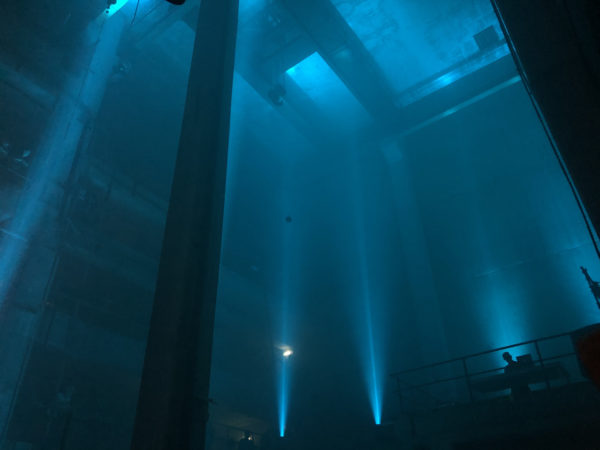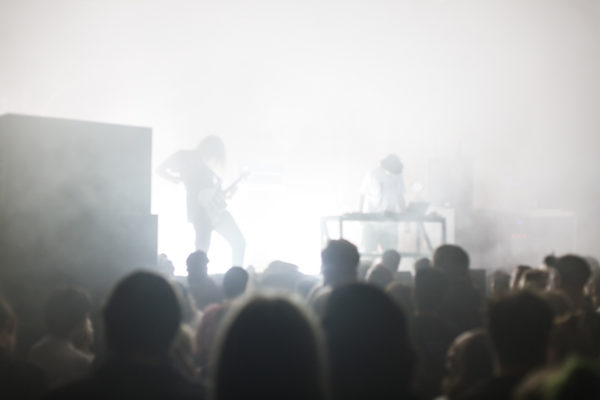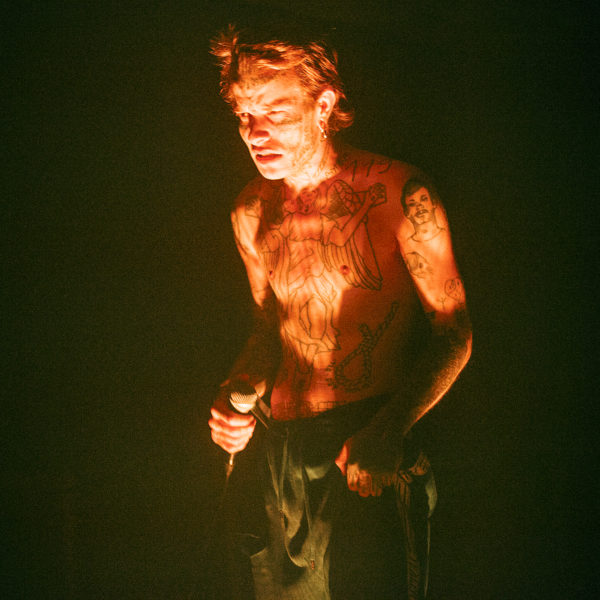An impressive backdrop awaits visitors as they arrive at the grounds of the Norbergfestival: In glorious sunshine, the tower of the Mimerlaven iron mine, which ceased operations in 1981, stands out against the horizon. In the interior and in the adjacent electrical center of the complex, in which many of the local population once had found employment, a carefully curated program of underground musicians and artists from Europe and overseas is presented throughout the weekend. The festival celebrates its 20th anniversary this year. It still operates on a relatively small scale: Nearly 1000 people, mostly from Sweden and Denmark, many of whom work voluntarily at the festival, get together. They meet here because the unique location is predestined for electronic music and art suited to the re-use of infrastructures abandoned by industry since their beginnings. All three main stages of the festival, and in particular the main hall, called “Mimer”, which is an overwhelming visual experience, are stage-managed flawlessly by the festival’s technicians. Throughout the weekend, both sound and light are amazing. In terms of staging, the festival is in no way inferior to more commercial spectacles – if anything, it outdoes them by replacing megalomania and kitsch with an impressive minimalism.
On entering the site, however, Norbergfestival initially appears like an outdoor rave. Under the concrete pillars of a corridor extending from the main building into the open sky, one is confronted with a small tent village. In front of it, right in the center of the festival site in a small party tent, there is the “Really Open Stage”, where various people romp around on a small machine park of synthesizers until the evening hours. The cacophony, which already resounds upon the arrival on site, would continue for the whole weekend. One could not shake the feeling that visitors and even the festival curators sighed from time to time whenever they passed the tent. The sympathetic DIY-idea, which carries and shapes the festival and which makes sure that one feels welcome and excited right from the beginning, also seems to demand some compromises as far as the festival’s curation is concerned.
The 303-Stage, which is located under a tent in the outer area opposite of the electrical center called Kraftwerk, also primarily seems to be committed to a bottom-up ethos. Stemming from an initiative of the audience – originally it was a non-official, improvised stage – it is now featured in the official program of the festival and is part of an attitude stated in the editorial of the program: to questioning top-down curation. That’s commendable – and the 303-Stage delivered a few great moments throughout the weekend by renown acts that made every effort to keep the ravers happy. Yet, the vibe really only seemed to be sustained during the set of DJ Presscott: with her crew behind her, the Stockholm- and Gothenburg-based DJ played a superb, energetic mix of jungle, hardcore, juke, and other related styles. Sympathetic and tight – although her MC Dr. Echoe cooled down the floor at times instead of heating it up.
Not only in terms of DJing, but also in terms of her live performance in general, LOFT, an artist and DJ living and working in Manchester, was the highlight of the festival. What the up-and-coming performer, who represents the rising young and queer scene of the northern English town with her party-collective BOYGIRL, pulled off at Norbergfestival, was simply mesmerizing. Her one-hour appearance, opening the Kraftwerk-Stage on Thursday evening, led to dropped jaws and goosebumps. The DJ set as such was dominated by own edits played at frantic speed. It refused classical transitions and instead produced an almost fractal progression, interrupted only by performative moments in which LOFT, appearing in a witch-like drag and in make-up, scolded her audience, joked, or screamed over harsh noise. Amazingly, you could catch yourself dancing again and again in between, tossed around in a mix of drums clashing in insane crescendos. The sound and light crew also played its part in making you feel more in a high-end club than in an off-location, producing the perfectly coordinated show. It was to remain the most outstanding performance throughout the weekend, even if the Duo Bliss Signal – Nino Pedone (Shapednoise) and James Kelly (Wife) – also provided an impressive and intense performance on Saturday. The same could not be said of the feeble performance of Easter on the same evening though, that had a substantial part of the audience clearing the room after a few songs. Giant Swan, on the other hand, had the crowd under control the night before and, as usual, offered a dynamic and energetic show for fans of techno’s tougher side.
The crowd favorite though seemed to be The Empire Line on Saturday night, according to various conversations on-site. That’s astonishing – because what the Scandinavian trio consisting of Jonas Rönnberg (Varg), Christian Stadsgaard (Vanity Productions), and Isak Hansen (Iron Sight) had to offer was a rather platitudinous populist message. Even though politically not aligned with the now almost unanimously rejected Power noise adventures of groups like White House, the sound drew from this tradition aesthetically. In terms of content though, the band’s main tenor was a condemnation of “the system”, railing against the cops and calling for an end to homophobia. This was accompanied by a visual projection, featuring graphic material pulled from first-person shooters and Gilets Jaunes demonstrations. Aside from the fact that the diverse audience, encompassing all possible shades of gender, probably already had internalized the anti-homophobic message, it also remained unclear how this adolescent appeal for Revolution (with a capital R) could be interesting in the context of the festival. Or is the whole project just a cynical joke on a politically correct underground? This remains unclear. The majority of the crowd, however, seemed to enjoy the concert.
The solo appearance of one third of the trio, Isak Hansen aka Iron Sight, in the cathedral-like hall of the Mimer on Friday, turned out to be to more convincing. Underlined by deafening noise, the bare-chested Hansen screamed his anger and desperation into the audience, which was spread out over the different levels inside the hall. The performance was intense and thus left out some of the subtleties of ssaliva’s concert on the opening night. The Belgian producer managed to evoke a feeling of melancholia with his baroque compositions, which seemed to recall the grief over the industrial decline symbolized by the abandoned mine that persists as a reminder to a different era of the shrunken town of Norberg.
The communication with the local officials and the community is continuous and open, according to the crew of Norbergfestival. The shops in town have also managed to prepare for the crowds of visitors travelling from the Scandinavian centers of Stockholm and Copenhagen. Norberg has evidently become acquainted with the idea that an important employer has now become a place that is seized once a year by young people, and that this is the only time the sound of different machines may be heard coming from the abandoned mine. However, the music of the mining industry has been playing farther to the north for a while now and on another scale. One of the world’s largest iron mines on Mount Kirunavaara in Lapland, operated by the state-owned Luossavaara-Kiirunavvaara AB (LKAB), continues to dig so successfully and profoundly that the nearby town of Kiruna, founded in the early 20th century, is in danger and need of relocation. Further to the east, on land of the Sami, the indigenous people of Lapland, the city now emerges anew – and the 21 most important buildings have been transported there as a whole. The relocation is estimated to cost about one billion euros, financed by the LKAB, which can afford to do so in light of the continuing excellent export business with China. Renderings of the future city depict a busy urban center with garlands of light. You can already hear intrusive generic pop played from the H&M branch pictured in one of the streets. In Norberg, meanwhile, quiet should have returned, at least for now.
The post-industrial periphery in Sweden is described well by Daniel Iinatti, a co-curator of Norbergfestival, and Anna Sagström, who run the label Country Music together, in an interview with zweikommasieben (see issue 17). This interview can now be found online and it provides a very appropriate context—you can read it here.


